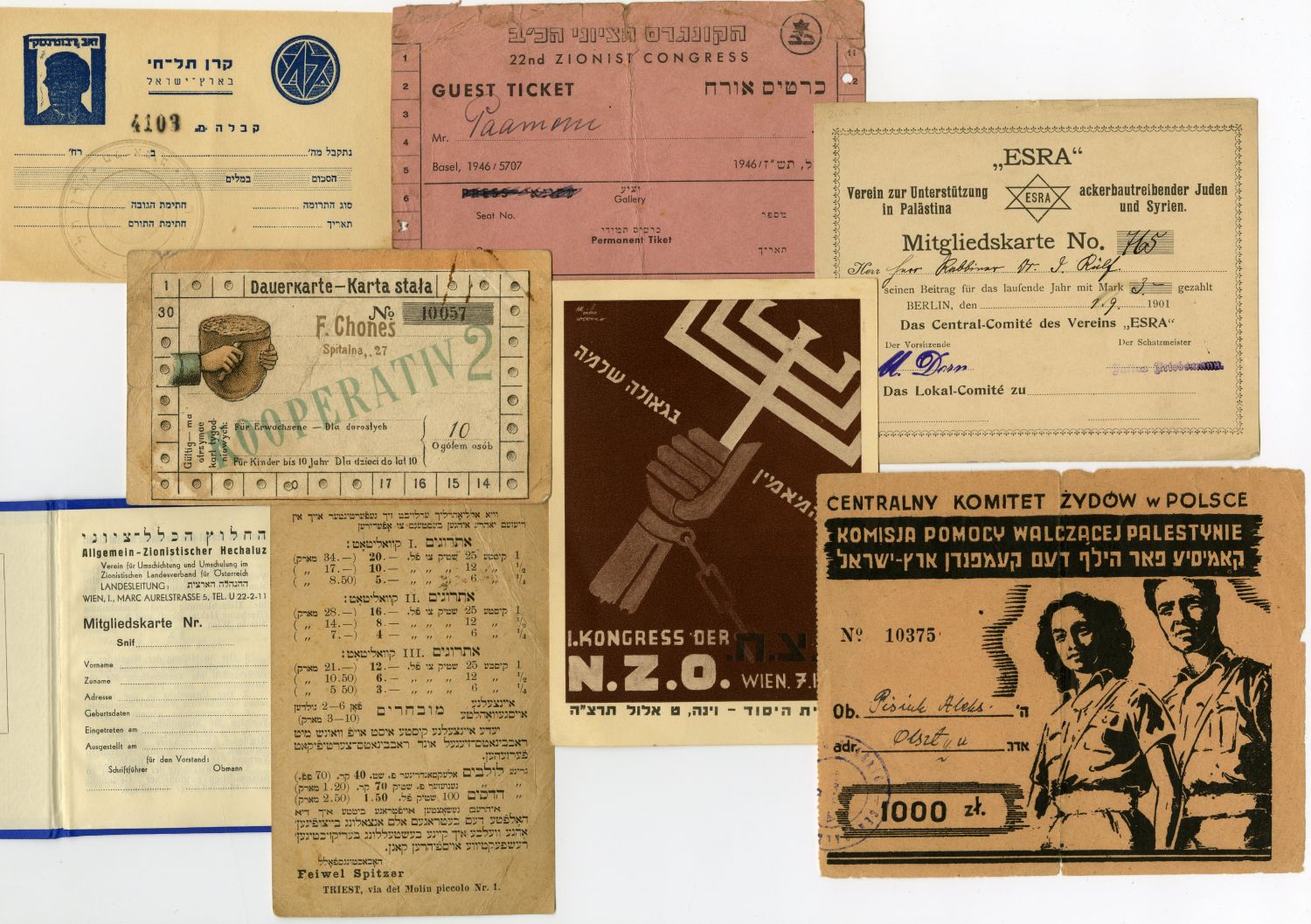
21 Early Jewish Paper items, Europe and Eretz Israel. The first decades of the 20th century. Among them: a guest card for the 22nd Zionist Congress - Basel 1946, an early and rare postcard on which an etrog price list of the Pile Spitzer Etrog Orchard - Trieste 1891, a receipt "for the benefit of a feast and learn boys", a postcard from D. LOWY's factory with "kosher" certificate - Vienna , A rare postcard with food stamps for bread from Cohen's store - Germany 1916. Set of 10 'Tzalilyot' postcards by Meir Gur Aryeh, published by Bnei Bezalel Jerusalem with the original cover, and more.
Various sizes, general condition good.
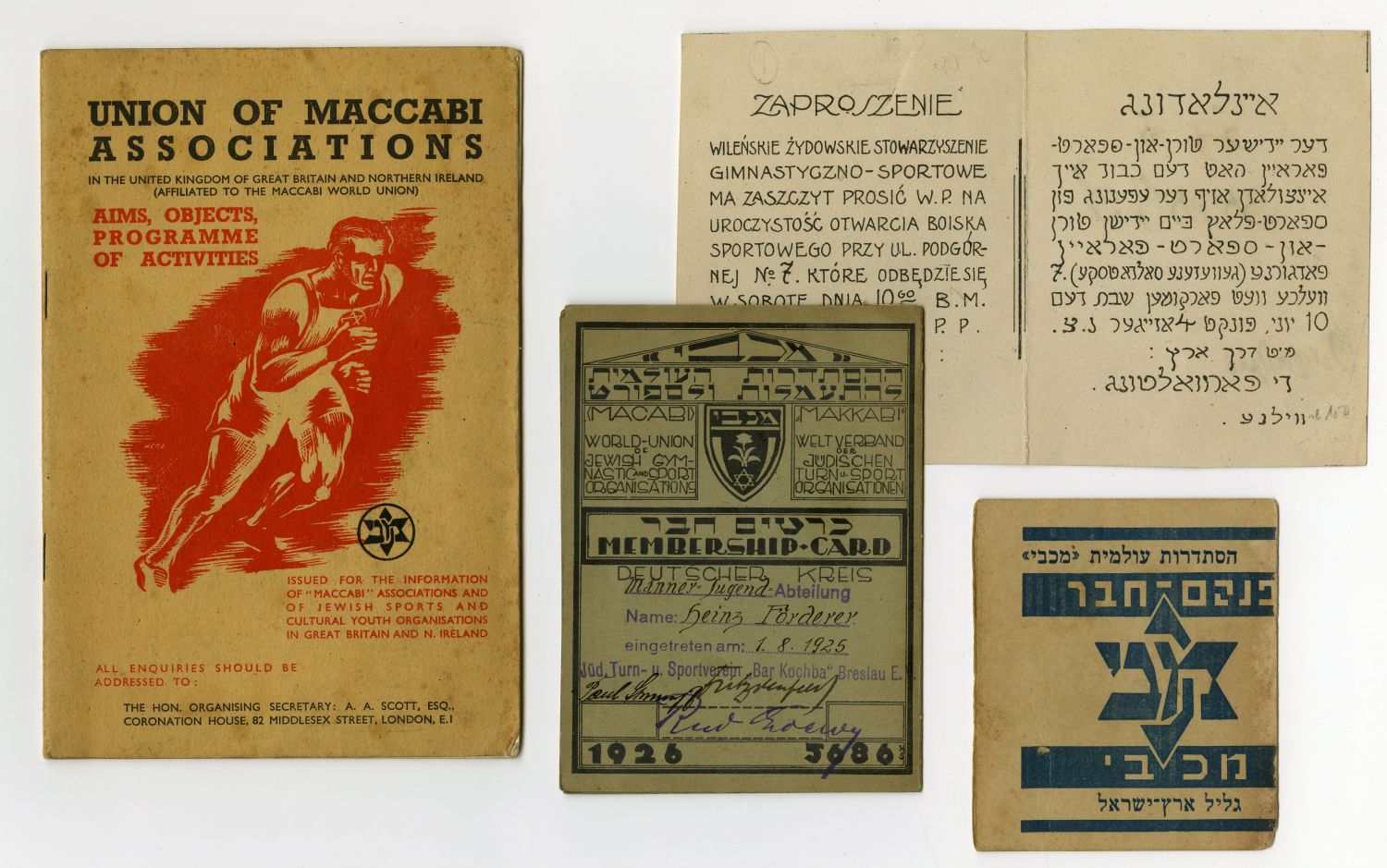
10 personal cards and brochures - Hebrew sports organizations in Europe and Eretz Israel. 1920s - 1940s.
1. Membership card from the World Federation of Gymnastics and Sports 'Maccabi' in Germany. Full of rare stamps of the Histadrut Maccabi. 1926. The details were filled in on 8/1/1925.
2. Membership register on behalf of the Histadrut Maccabi - an active member. Galilee Eretz Israel, 1936/7. Cardholder Aharon Twig from the swimming department, with Maccabi Haifa with Member Tax Stamps
3. A designed invitation sent to Dr. Shabad on the occasion of the opening event of sports competitions for Hebrew teams in Vilnius.
4. Entrance ticket to a football game between the Lebanon team and the Palestine team held at the Maccabiah Stadium - April 27, 1940.
5. Booklet published by the UNION OF MACCABI ASSOCIATION - Maccabi Association in the United Kingdom and Northern Ireland in 1944. An extensive review of Maccabi's sports activities in the world. In the booklet, among other things, important photographs and data.
6. Member's notebook of the 'Elitzur Religious Sports Association in Eretz Israel' by Shlomo Blimer No. 138, the details were filled in on Tishrei 1950.
7-10. Four issues of Der Makkabi, Berlin. Two issues from 1928 (numbers 3, and 9), and two from 1930 (numbers 10 and 12). Ongoing reports and photographs of Maccabi's activities in Berlin before the Nazis came to power.
Various sizes. general condition good.

11 Official Documents from the British Mandate Period - Contracts, and Personal Documents - Government of Palestine.
* Two 'Palestinian citizen' certificates, one of Shimon Shimshoni, and the other by Avraham Polak - passport photos of the owner. 1925, and 1926.
* Contract for the purchase of a 39-dunam plot of land purchased in the Yeffeh Nof area - Arabic, Hebrew, and English. Signature in Hebrew 'In the name of Rabbi Shachor'. December 1924.
* Ottoman birth certificate.
* Certificate of land registration of Senora Bat Ezra Shemesh - September 1940.
* 6 'Bonds demanding payment' sent to 'Hekdesh Etz Chaim' according to the Municipal Property Tax Ordinance, Jerusalem, 1943.
[11] Paper items in total. general condition good.

A scathing proclamation issued by the Irgun after the bombing of the Palestinian Central District of Jerusalem and its destruction, in the months when it declared open war against the British rule in Eretz Israel. Tammuz 1944.
The proclamation announces that the Hebrew youth will rise in rank in its war for the liberation of the homeland and the redemption of the people: "We will not be silent and we will not lay down our arms as long as the gates of the land do not open before our people, as long as the rule is not handed over to the Hebrew government. Threats will not deter us, a death sentence will not frighten us." Irgun members accuse the Palestinian police of using the Gestapo's interrogation methods: "Hebrew Prisoners Tortured by Death-Calling Calgary", And address the exception directly and with a clear warning: "We have so far refrained from retaliatory actions against you because our war is not a war of revenge ... but if you continue to rule Nazi customs in our country - we will draw ... the conclusions: the court of the national military organization will judge the criminals and those responsible for their actions - without mercy", And also appeals to Hebrew youth to join the struggle.
The proclamation before us was published in the months known as the beginning of the 'revolt' in British rule led by Menachem Begin, with the escalation of the armed struggle of the Irgun organization. In February of that year, the Irgun published the proclamation 'Declaration of the revolt'. The document declared that from the Irgun's point of view the armistice against the British was over and that war was now being waged against it. The police in the Russian compound, and attacks were carried out, when the buildings were empty, in the offices of the three major cities - Jerusalem, Tel Aviv and Haifa, and more.
[1] leaf. 27x17 cm. Very good condition.
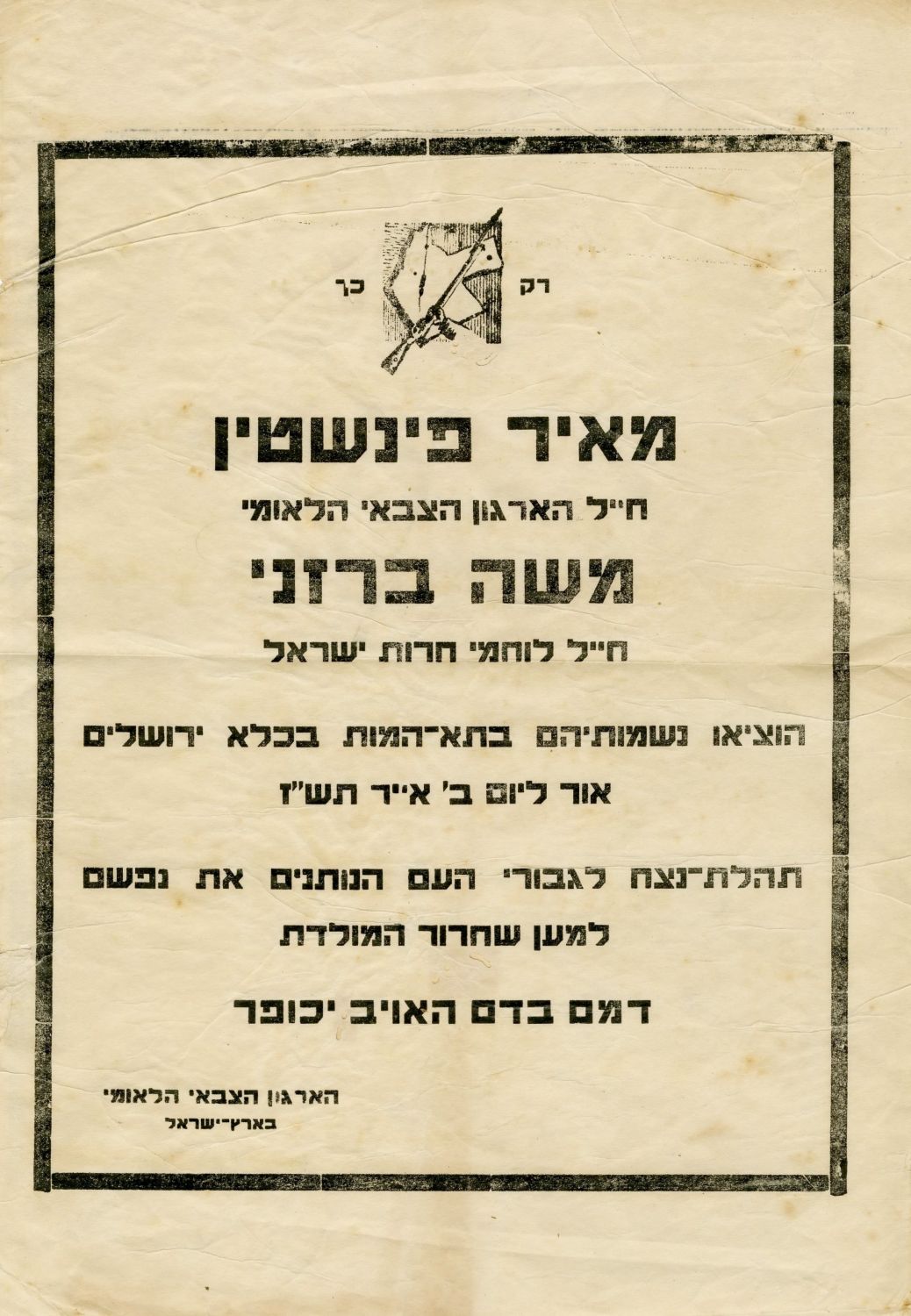
Three posters issued by the Irgun organization on the deaths of "Olei HaGardom" , 1938-1947.
* Mourning notice on behalf of the Irgun about the deaths of the "Olei HaGardom" Dov Gruner, Dov Rosenbaum, Mordechai Elkushi and Eliezer Kashani: 1947. 36x25 cm. Stains, tears in margins.
* A statement from the Irgun on the deaths of Meir Feinstein and Moshe Barazani: 1947. 36x25 cm.
* "Yizkor" ad in the death of Shlomo Ben Yosef: "... the blood will not be silenced Until the entire State of Israel will be established in his liberated land" [June 1938]. 13x16 cm.
Shlomo Ben Yosef [1923-1938] An illegal immigrant and Betar fighter in Eretz Israel, one of twelve "royal martyrs" ( "Olei HaGardom" ) during the British Mandate. Executed for attempted revenge on Arab bus passengers in response to the execution and murder of nine Jews .
Meir Feinstein [1927-1947] : Caught after placing bombs in suitcases at the Jerusalem train station that resulted to the killing of a British police officer who tried to dismantle. He committed suicide in the prison cell along with Moshe Barzani on April 21, 1947, about four hours before the date set for their execution.
Moshe Barzani [1926-1947]: Caught carrying a grenade, and charged with attempting to assassinate the military commander of Jerusalem.
Dov Gruner [1912-1947]: Arrested during the attack on Ramat Gan police. Executed on April 16, 1947.
Eliezer Kashani [1923-1947] An Irgun underground fighter who was captured by the British when he went into action as part of the 'flogging night', sentenced to death and executed by hanging.
general condition good - moderate.
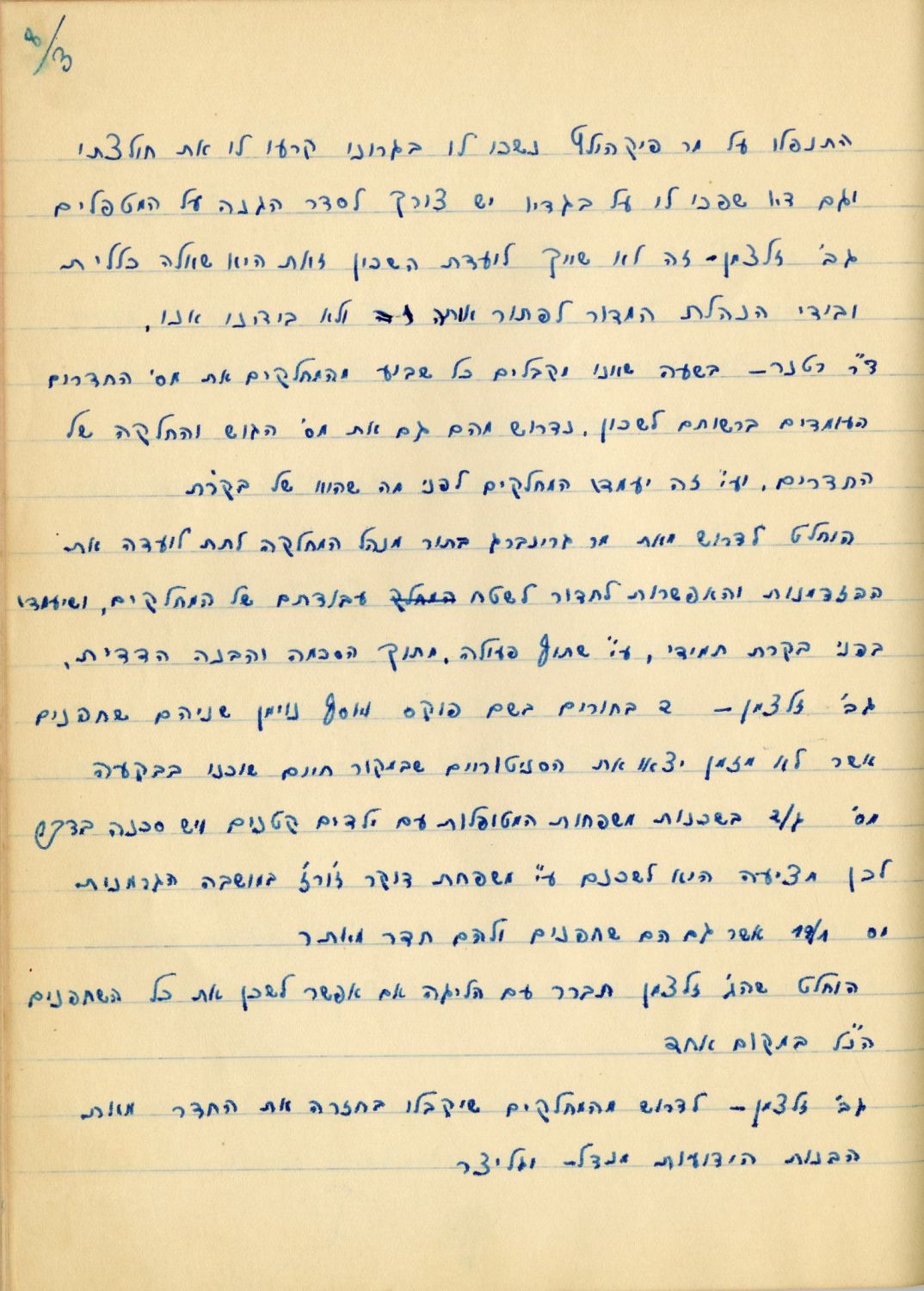
Handwritten notebook, with detailed protocols of the Immigrant Housing Committee established to arrange the immigrants of the various countries in permanent residences. Israel, June - November, 1949.
The committee was established by members of various parties: the Neighborhood Division, the Etzion Immigrant House, and the Social Department. As detailed in the summary of the committee's first meeting, its functions were: "to manage all the affairs of the neighborhood, to schedule the distribution of apartments, and to decide from time to time on exceptional cases, or social cases in need of apartments or special apartment conditions ...". before us a very important historical source that allows a broad glimpse into the decision-making process in which apartments were distributed to the first immigrants who arrived in Israel in the first year of the establishment of the state. For example, the interesting datum is that 72% of the immigrants refused to accept the apartments offered to them due to their disgraceful conditions, and that there was a preference in dividing the apartments into families with large families of six or more, as well as a description of disputes between immigrants and neighbors. Disputes over cooking on Shabbat, and the use of prohibited utensils. On one of the pages of the protocol there is a detail about "What do you get the right to get an apartment", among the criteria that appear: a large and heavy family whose camp life is difficult, the date of immigration, and a section from which we can learn about The Zionist motives in the distribution of apartments: "Even for an immigrant who is already settled in a permanent job ... he deserves a housing even though according to the date of his immigration his turn has not yet come ... because by giving him the housing we make it great to be a citizen and a permanent resident who is very desirable to the community, and from it others will learn to do the same". And other interesting details in the fateful process of the absorption of immigrants in the permanent residences, which influenced the character of the various areas to this day.
See also Dynasty, auction 11 Item No. 18.
[43] Written pages. Unbound notebook. Very good condition.
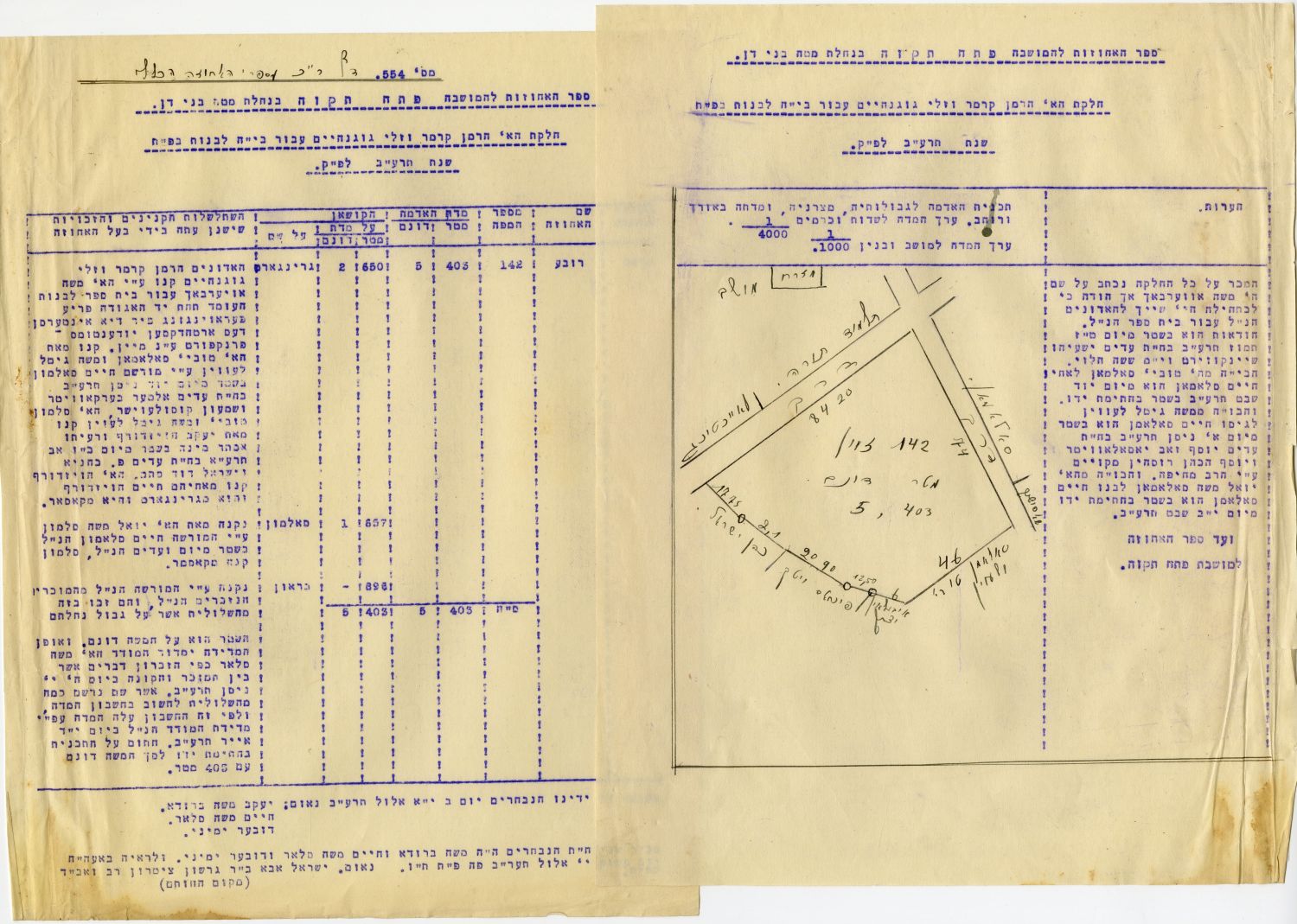
An interesting collection of land purchase documents for the girls' school in Petah Tikva from Yoel Moshe Salomon through his successor - his son Chaim Salomon - Petah Tikva, Shvat 1912. (Several months before the death of Yoel Moshe Salomon).
Detailed sales notes about the purchase of land that belonged to Joel Moshe Salomon, which he sold to Herman Kramer and Zali Guggenheim from Germany for the construction of a girls' school in the city. Among them: the original Kushan detailing the terms of the sale and the size of the area sold (5 dunams), 'the sale on each plot is written in the name of Moshe Auerbach', as well as a sketch of the area and the various owners on its parts. There is also a handwritten document "Zichron Devarim" written in Nissan 1912, "Here in Petah Tikva", signed by Haim Salomon, son of Yoel Moshe Salomon (founder of the city of Petah Tikva), and Moshe Auerbach. This document details the boundaries of the land purchased in great detail. In addition, documents printed on a typewriter written in 1926 appear, related to the ownership of the company in Frankfurt, which owns the above-mentioned area.
About 20 pages in total. general condition good.
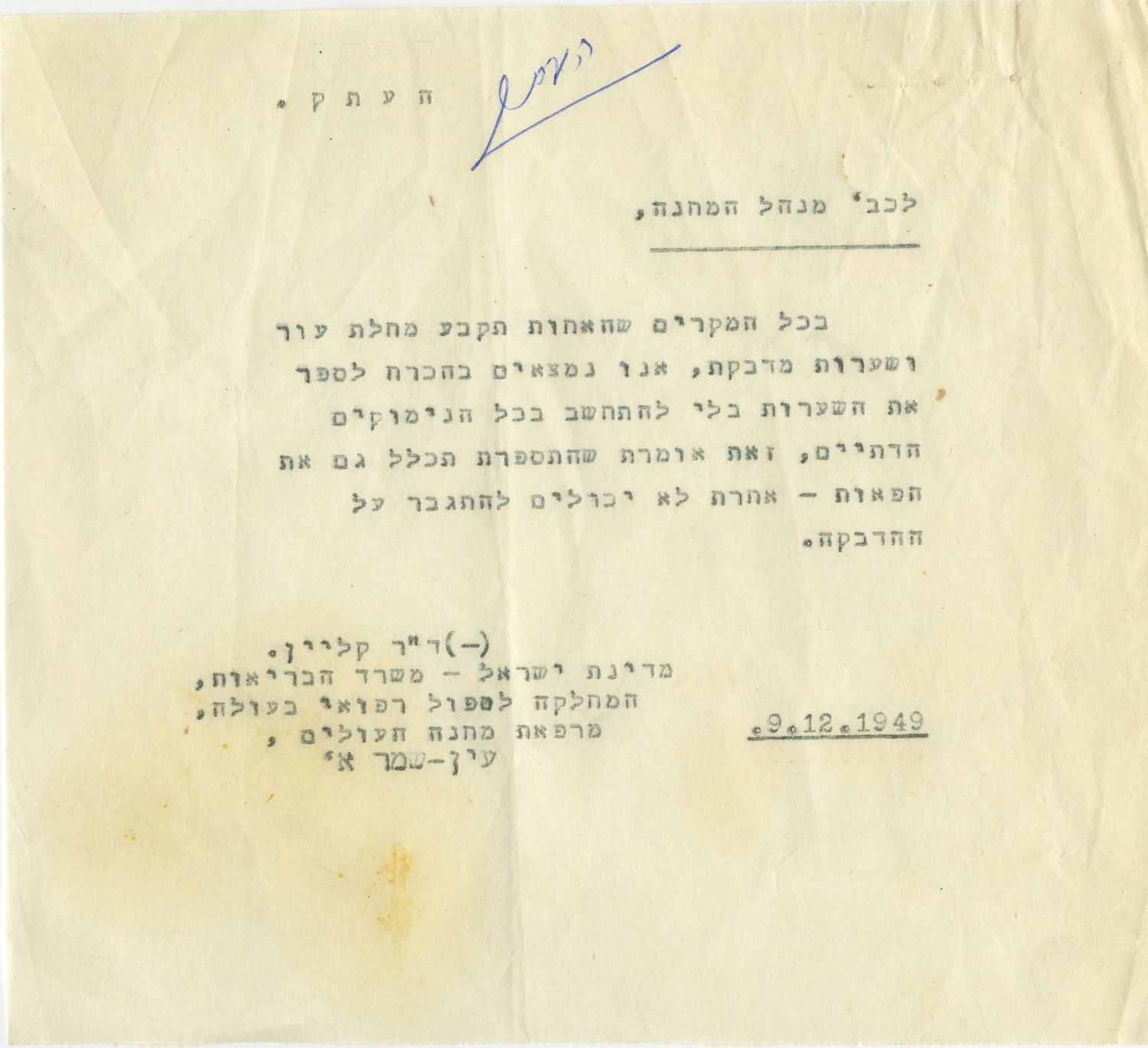
After many complaints were filed by religious sources about religious discrimination against religious immigrants in the immigrant camps in 1949 and the early 1950s, a ministerial committee was set up to examine the 'matters of enlightenment in the immigrant camps', after re-examining the committee comes with a detailed report describing the dismal situation of the religious immigrants in the immigrant camps, and the attempts to seduce the religious immigrants, and the deliberate reduction of educational resources to the religious groups. before us stencil-printed pages with objections to the report submitted, and accompanying documents dealing with the committee's conclusions. From the leaves before us emerge the serious findings regarding the difficult encounter, and the attempts to transfer to religion from their faith. Collection of printed pages in stencil, Israel, 1949-1951.
A document in response to the results of the committee's conclusions reads: "The committee recognizes that there have been cases of cutting off peot for health reasons ...The committee took into account the possibility of Ashkenazi phenomena in Yemeni boys, The possibility of the adaptation of some of the new Yemenite immigrants to the custom of the country, by their relatives who have Ashkenazi, while visiting their home, the possibility of malicious acts by elements who have infiltrated outside camps! ... In any case, the department did not issue a circular "How to cut the peot of Israeli children ...". It was also written about movies brought to the camp : "As for the accusation of bringing movies to the camp that harmed the morals and modesty of its occupants, It is a fact that the department brought only the Jewish National Fund and the Keren Hayesod film to the camps. Ordinary movies were shown in the camp by the "Culture for Immigrants" section of the Histadrut." There are also harsh descriptions of: children from Rosh HaAyin who are precisely those who study Torah do not receive clothes and shoes, of "disturbances in Torah study", of "sanctions against religious teachers", evidence of smoking on Shabbat in the Atlit camp, "disturbances during prayer", of discrimination Receiving religious teachers for the immigrant camps, evidence of discrimination in the Talmud Torah in Pardes Hanna Camp III, horrifying testimony given by Ms. Landau, a Torah teacher at the Beer Yaakov immigrant camp, in which she tells how Natan Mamoni entered the religious girls' class where she studied, and inevitably announced in the middle of the lesson about A folk dance evening that was to take place at the youth center. A document appears on behalf of the "Teachers' Association in Ein Shemer" in which they deny that peot were cut in the camps, and deny that hacking dances of youth in the camp were organized, and also deny most of the accusations made by the committee. In addition, there are lists with the names of the youth counselors in the immigrant camps, programs of cultural activities in the camps, leaves with various instructions from the Ministry of Education and Culture, and more.
Among other, there is a document from December 9, 1949, written by Dr. Klein from the clinic of the Ein Shemer A. immigrant camp, from which one can learn about the sad phenomenon of cutting peot in medical disguise. The document reads: "In all cases where the nurse prescribes skin disease and contagious hairs, we are necessarily to cut the hairs without taking into account all the religious reasons, that is, the haircut will also include the peot - otherwise the infection can not be overcome, " and more.
About 70 leaves in total. Several leaves appear in two copies. general condition good.

The regulations of the Sephardic community in Hebron - Shvat new moon 1937. Typewriting.
Regulations for the Sephardic settlement that was to return to Hebron After that in the riots of 1929, there were almost no Jews left in Hebron. Among the regulations that appear: "The company's Palterin is temporarily in Jerusalem and will be transferred to Hebron when the Jewish community returns there, the company's goals are: ... to return to the Hebron community refugees who left due to time constraints and provide them all their spiritual and religious needs... to elect a chief rabbi and reorganize the rabbinate and courts of justice ... to preserve the graves of the saints and other holy places in Hebron ... The members: Every Sephardic Jew over the age of 18 who is a resident of Hebron or was a resident of Hebron can be accepted as a member of society ... Once a year a general meeting of the company will convene ... ".
In 1927, the Ashkenazi and Sephardic communities were represented on a committee called the "General Committee of the United Hebrew Community in Hebron". The committee was chaired by Rabbi Meir Shmuel Kashmir and Rabbi Yaakov Yosef Slonim. The Av Beit HaDin of the last Sephardic community in Hebron until the riots of 1929 was the saint Rabbi Hanoch Hasson [1867-1929]. In the riots of 1929, Rabbi Hasson and his wife Clara were murdered in their home during the Hebron massacre. Three days after the massacre, the British authorities decided to eliminate the Jewish community in Hebron. The remains of the Jewish community in Hebron were moved to Jerusalem. The houses of the Jews were looted by the rioters. The Hadassah House was converted by the Arabs of Hebron into a girls' school, the Avraham Avinu synagogue was destroyed and a goat shed was built on it. The ancient Jewish cemetery was also desecrated and destroyed. The Jewish settlement in Hebron was renewed for a time in 1930 by 36 Sephardic families numbering about one hundred and sixty people. With the outbreak of the Great Arab Revolt in 1936 (the events of 1936-1939), the last Jews left the city (except for one family). In the specification of the regulations before us, a first attempt was made to return the Sephardic community to the city in the form of regulations for the future, when the Sephardic settlement returned to the city, which actually took place only after its re-occupation in the 1967 Six Day War.
[7] leaves. 33 cm. Good - very good condition.
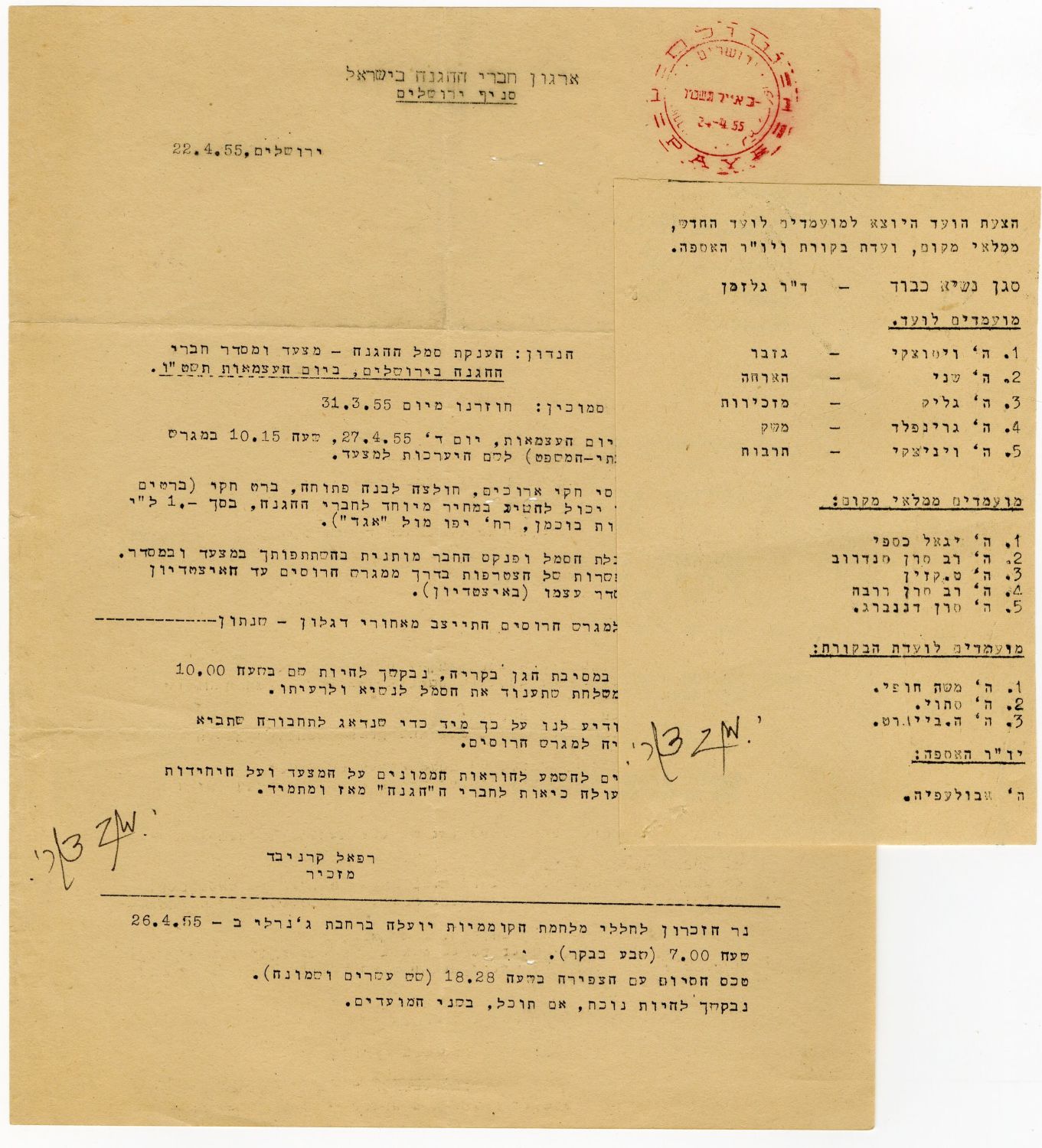
A collection of early documents in stencil, from the day-to-day activities of the "Organization of the "Haganah" Members of Israel" - the Jerusalem branch in the early 1950s, including important documents signed by the first IDF Chief of Staff, Yaakov Dori.
Among the pages that appear: a proposal of the names of candidates for the organization committee with the signature of Yaakov Dori, Official invitation to award the protection emblem signed by Yaakov Dori, details of the symbol distribution ceremony and a permanent book (winners had to pay for the symbol: "Price of the symbol and the notebook, total 1 Israeli pound") A 'very personal' page calling for a report to the Israel Police reserve composed of former Haganah members, pages detailing the details of establishing a neighborhood for Haganah members in Talbiyeh, including the rights given to members to purchase discounted apartments, a circular regarding the members' meeting, and decisions made there, details About a joint activity of the former Haganah members - a trip to Eilat for the organization's members under the guidance of Zeev Vilnai, weekly programs that took place at the Menorah Club's Beit Katzin, and more.
The Haganah organization was established after the War of Independence, and those who were members of the Haganah until the day the IDF was established became members. With its establishment, the organization numbered thousands of members who were organized in branches around the country. The organization and its branches have in the past and also today held various activities to instill the "Haganah" heritage and to provide information about the organization and its work to the younger generation and the general public. In the early years, the organization engaged in the integration of former Haganah members into IDF defense systems, in later years the organization was mainly engaged in cultural activities, and passing on the Haganah's legacy to future generations.
Yaakov Dori (Dostrovsky) [1889-1973] The first Chief of Staff of the IDF, in the years 1948–1949. Served as Chief of Staff of the Haganah from 1939–1945 and 1947–1948. President of the Technion from 1951–1965 and Deputy Mayor of Haifa.
About 50 pages in total. general condition very good.
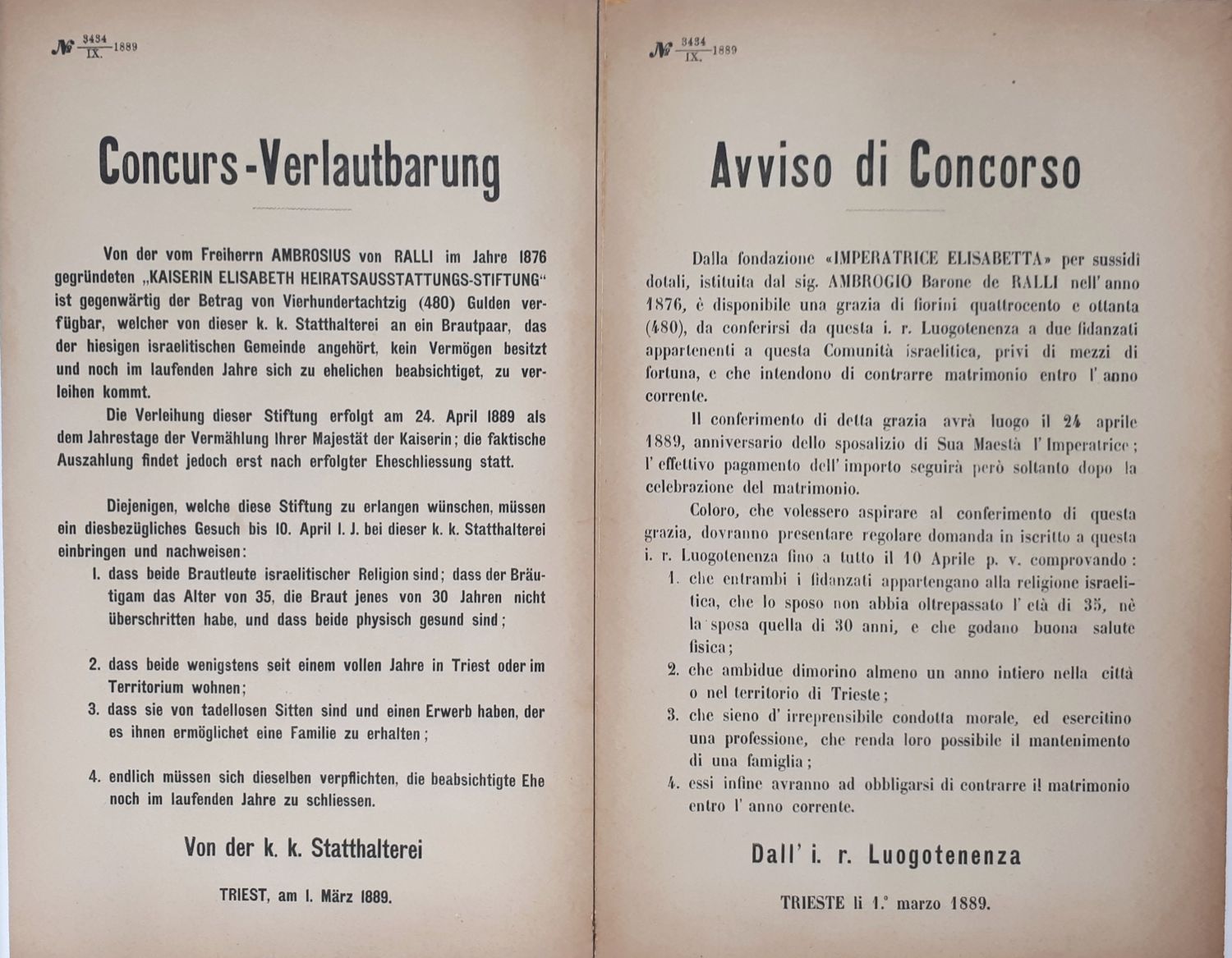
concurs - verlautbarung / Avviso di concorso - Poster - Announcement of a grant of 480 florins to engaged couples from the Jewish community who intend to marry in the current year - 1889. The grant will be awarded on the anniversary of the marriage of Empress Elizabeth on April 24, 1889. The notice states that the Jewish couples eligible for the grant will register on the Empress' wedding day, and the actual payment will be given after their marriage, and lists the conditions of those eligible for the grant: early registration, the husband and wife are healthy, the couple commits to stay in the country for at least a year, both have a profession from which they make a living, both live in Trieste, the groom is not over 35 and the bride is not over 30, and that they commit to marry after their engagement. Trieste 1889. German and Italian column by column.
Size: 45x37 cm. Glued to a hard substrate for storage and display. Very good condition.

Prayer 'To Pray in all the synagogues of Baden country on Holy Saturday ...' - single leaf - a special prayer connected to pray for mercy and peace and the success of the birth of Queen Wilhelmina Princess of Baden after she was got pregnant. "קול מבשר טוב משמיע ישועה לאמר הנה היא הרה, ותמלא ארצנו גיל וחדוה, ותרב תקות כל יושביה...".
Wilhelmina, Princess of Baden [1788-1836] Wife of Ludwig II, Grand Duke of Hessen. On June 19, 1804, Wilhelmina married her cousin Ludwig, the Crown Prince of Hessen, but the marriage was unsuccessful, and after the birth of her three eldest children, they separated.
Prayer for the success of any queen's pregnancy is extremely rare.
Leaf 35 cm. Stains. Tears at the top of the page. Good-moderate condition.

Printed Leaf, "Prayer to pray in all the synagogues of Badin country on Holy Saturday at dawn after HaNoten Tshuah ... During the days of pregnancy, Mrs. Grasshertzagin Stephen the Royal ..." Stephanie de Boerne - wife of Carl, Duke of Baden. [Duchy of Baden, now Germany, around 1811-1817]. "אדון כל כעבדים בכריעה והשתחויה באנו לחלות פניך... שים נא עין חמלתך עליה ועל פרי בטנה...".
Stephanie de Boerne gave birth to Carl Duke of Baden five children, the first in 1811 and the last in 1817.
Prayer for the success of any queen's pregnancy is extremely rare.
Leaf, 35 cm. Slight tears. Stains. moderate condition.
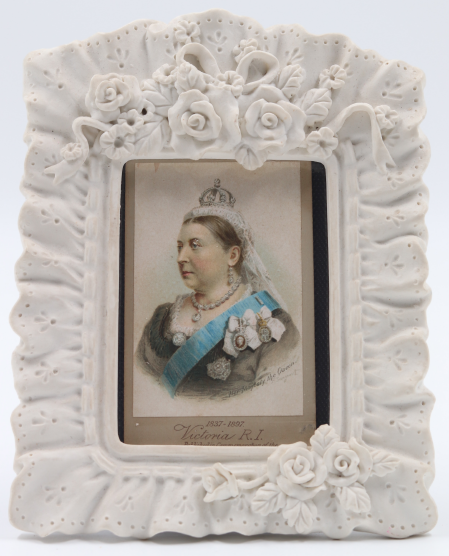
Her Majesty the Queen - a rare color photograph published on the occasion of the 60th anniversary of her reign (carte de visite size), published by the Queen's official photographer, the Jew "Raphael Tuck & Sons Ltd Publishers to the Queen". England 1897. Magnificent white frame with leaf and flower Embossed.
The English Jewish Tuck distribution plant opened in London as early as the 1870s. In the world of photographs and the first postcards ever published, a place of honor is save for Tuck and Sons' agency. Thanks to the beautiful postcards he created that were considered groundbreaking in the field of graphics at the time, he was chosen to supply graphic materials to the British royal court. Tuck employed the best graphic artists and designers, and due to the demand he supplied his products even to the non-Jewish population. In the last decade of the 19th century, Tuck's agency opened a branch to distribute its goods on Broadway in New York, at which time the agency excelled in printing Jewish 'Happy New Year' postcards.
Victoria, Queen of the United Kingdom [1819-1901] Granddaughter of King George III, and last British control of the House of Hanover. Victoria was Queen of the United Kingdom from 20 June 1837 until her death, for 63 years and seven months, more than any British king who preceded her. She was also the first Empress of India, beginning on May 1, 1876. Her reign is named after her, "the Victorian period". It was the heyday of the Industrial Revolution, in which the United Kingdom underwent many developments in the fields of society, economy and technology. During her reign the British Empire grew greatly, and was considered the most powerful empire in the world. Victoria is considered one of the most powerful women in human history in general.
Size: 7x11 cm. Frame: 18x14 cm. Very good condition.
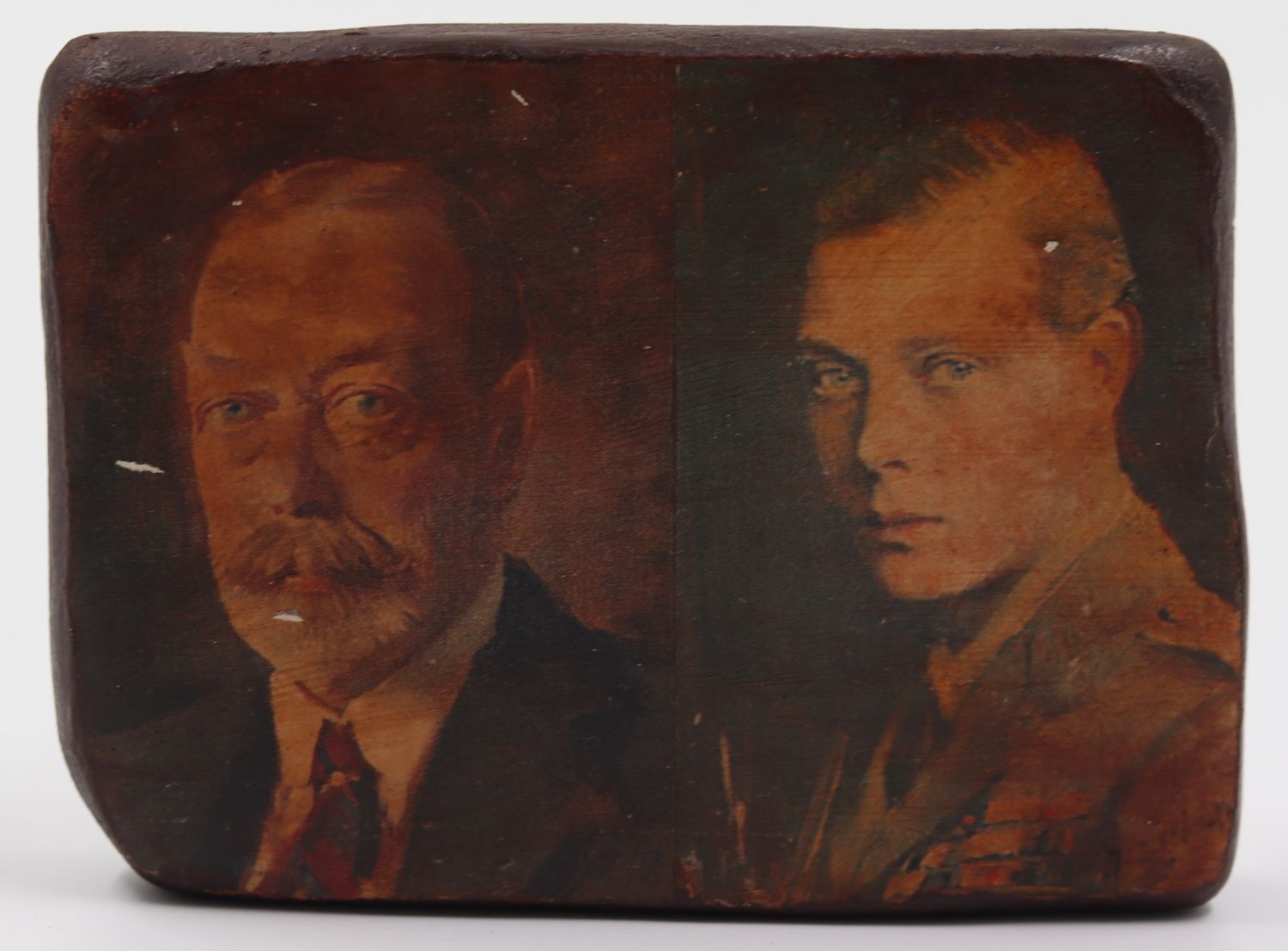
Portrait figures of King George V, and his son King Edward VIII - an ancient painting on wood. Signed: A. Brain.
George V [1865-1936] King of the United Kingdom and British Dominions, and Emperor of India, from May 6, 1910 until his death in 1936. (George V is remembered in the history of the Land of Israel as a king who during his reign issued a Balfour Declaration promising the establishment of a "Jewish national home" in the Land of Israel. Commemorated by naming streets after his name, in the big cities, Jerusalem, Tel Aviv, and Haifa).
His son, Edward VIII [1894-1972], King of the United Kingdom of Great Britain, Ireland and its protectorate and Emperor of India from 20 January 1936 until his resignation on 11 December 1936. (See more about him in the previous item)
Size: 11x8 cm. Wood thickness: 2 cm. On the back of the plate are two ancient nails for hanging. Good condition.
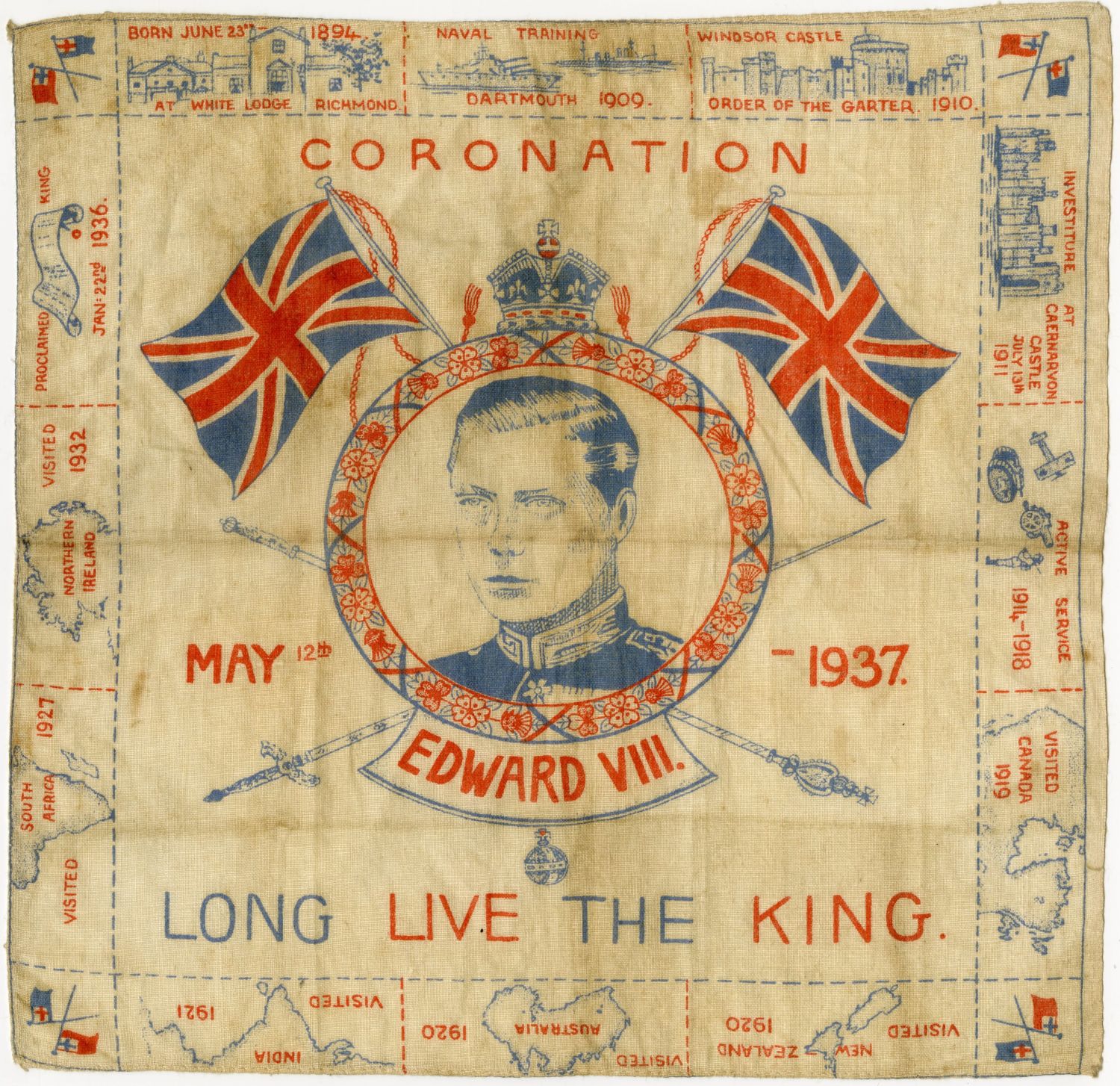
LONG LIVE THE KING - A canvas map issued in honor of King Edward VIII, King of the United Kingdom of Great Britain who relinquished the throne in favor of his marriage to the American Wallis Simpson, and in fact was the king who ruled the United Kingdom for the shortest time, less than a year, in 1936.
At the center, the figure of Edward VIII, British flags, and the date: May 12, 1937. All around, important dates in Edward's life, from his birth in 1894, his visits to the various countries, to his ascension to the throne in January 1936.
Edward VIII [1894-1972] King of the United Kingdom of Great Britain, Ireland and its territories from January 20, 1936 until his resignation on December 11, 1936. After the death of his father, King George V, on January 20, 1936, his eldest son - Edward, ascended the throne, named "King Edward VIII". Edward shocked the whole of Britain when he announced his resignation from the throne in light of his desire to marry the American Wallis Simpson, who was divorced and as a result their marriage was avoided according to the decision of the British government, to which the king is committed. In fact, British law knows no way the king can resign. Therefore, the next day, the British Parliament passed a special law approving the king's resignation, and revoking the title of his descendants as well. After relinquishing the crown, Edward received the title "His Majesty the Duke of Windsor", which was a purely symbolic title. The couple moved to France, where they married, and then lived in the United States and France. For many years members of the royal family were not in touch with Edward, as a kind of unofficial boycott. Just near his death he was visited at his home in Paris by his niece Queen Elizabeth and her son, Prince Charles. He was already too exhausted to host them. A few days later he passed away.
Souvenirs from Edward's VIII short reign are extremely rare.
Size: 30x30 cm. Stains. Good condition.
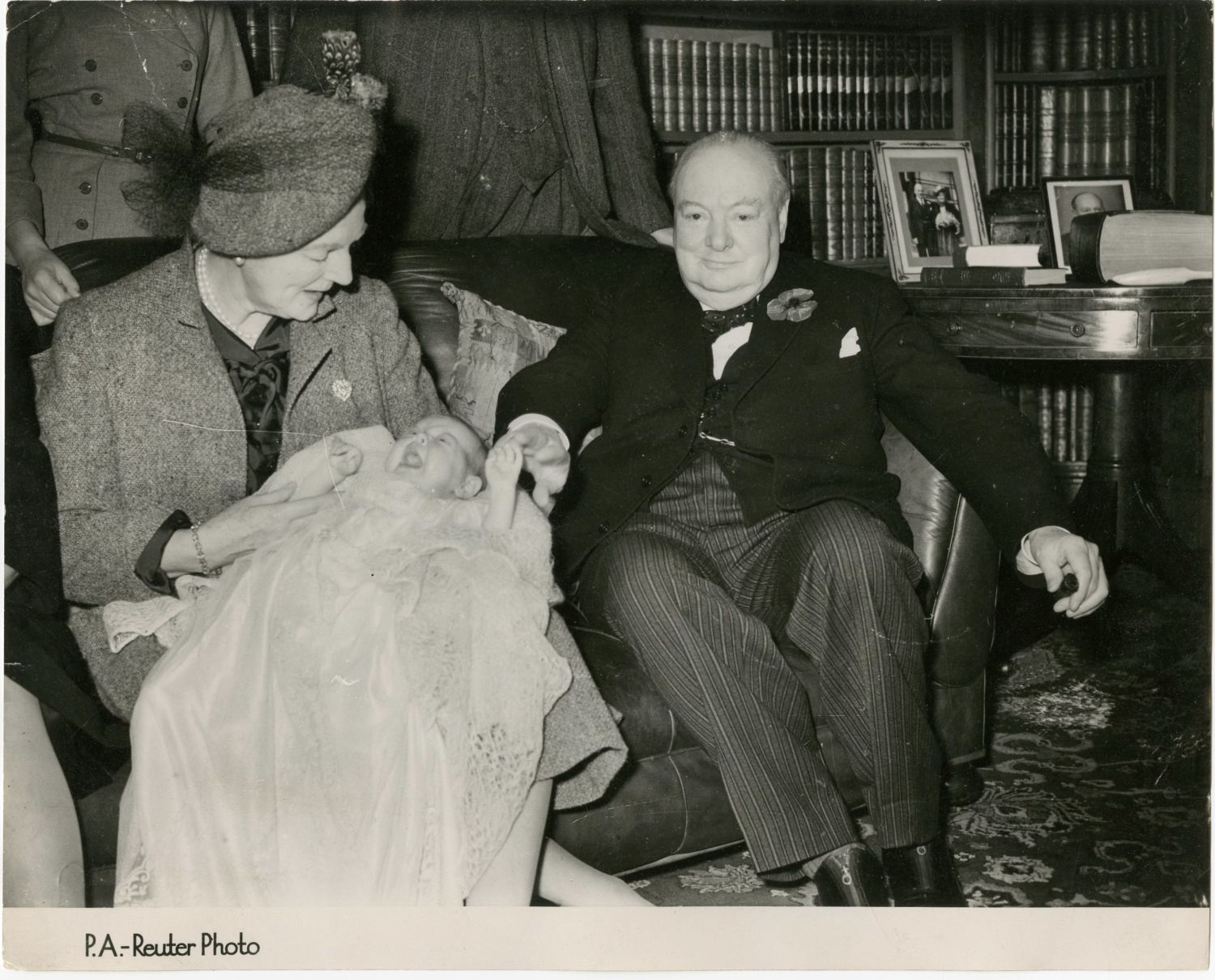
An interesting and important collection of 10 press photographs of British Prime Minister Winston Churchill [1874-1965] - various periods.
Among them are: rare photographs in which Churchill is seen next to his wife at their home at the birth of their grandson, in his office, next to his wife in the 1924 election campaign, marking with his hand the famous V sign, and more. Some of the photographs are depicted on their backs on pieces of glued paper.
Half of the photographs are 25x20 cm, the rest are average size: 20x15 cm. general condition good.

A historical photograph showing Albert Einstein and renowned film actor Charlie Chaplin entering together at the premiere of the screening of Chaplin's "City Lights" movie. The photo shows the excited Chaplin leading Einstein and his wife (standing right) as guests of honor at that famous event, which Einstein's biographer called: "one of the most memorable scenes in the celebrity era". Described on the back in handwriting: "With Charlie Chaplin 1931". California, January 20, 1931.
Einstein first met film actor Charlie Chaplin on the famous physicist's second trip to America, in 1930-31, when he was invited to lecture at the California Institute of Technology. Einstein was then at the height of his fame, when newspapers followed his every move and academics engaged and examined in depth his theories. Einstein was an avid film buff, and the encounter with Chaplin interested him more than the encounters with those physicists who sought his closeness. That December, Einstein arrived in America. He first spent a few days in New York where he was awarded the City Key Award before he got to California. In California, Carl Lamal, Universal Studios CEO of Hollywood, invited him to watch "All Quiet", Einstein took the opportunity and asked him to arrange a meeting with Chaplin. Lamel called Chaplin who was happy to meet the great scientist. The first meeting between Einstein and the comedy star took place at Universal Studios, where the couple took a tour and had lunch together, it was a fascinating meeting for the two stars each in his field. Chaplin wrote later in his autobiography about his impression of that meeting with Einstein: "He looked typical German in the most positive sense, cheerful and friendly. And although his character was calm and gentle, I felt he hid a most emotional temperament, and from this came his extraordinary intellectual energy." According to the same autobiography of Chaplin, during that visit Einstein's wife Elsa, took over the meeting, and invited herself and her husband to Chaplin's home. Einstein stayed at Chaplin's home for two weeks. And Chaplin added that Elsa Einstein told at the time that the "general relativity" of Einstein was conceived by him somewhere in 1915, while playing the piano, occasionally stopping his playing and taking notes, after two weeks handing her the paper with the conclusions of the theory and said "this is it."
Chaplin and Einstein kept in touch after that successful meeting. The actor invited Einstein to attend his next premiere, of the film "City Lights" (1931), as his special guest. When the genius and actor entered dressed in the same clothes with identical black bow ties (as can be seen in the photo), a line of photographers stood up to take a picture, and the crowd cheered for the two in droves. As is well known, when the crowds cheered for the couple, Einstein was embarrassed, and Chaplin explained, "They cheer for both of us, for you, because no one understands you, and for me because everyone understands me."
23.5x17 cm. Glued to the photographer's cardboard substrate: 31x25 cm. Good - very good condition.
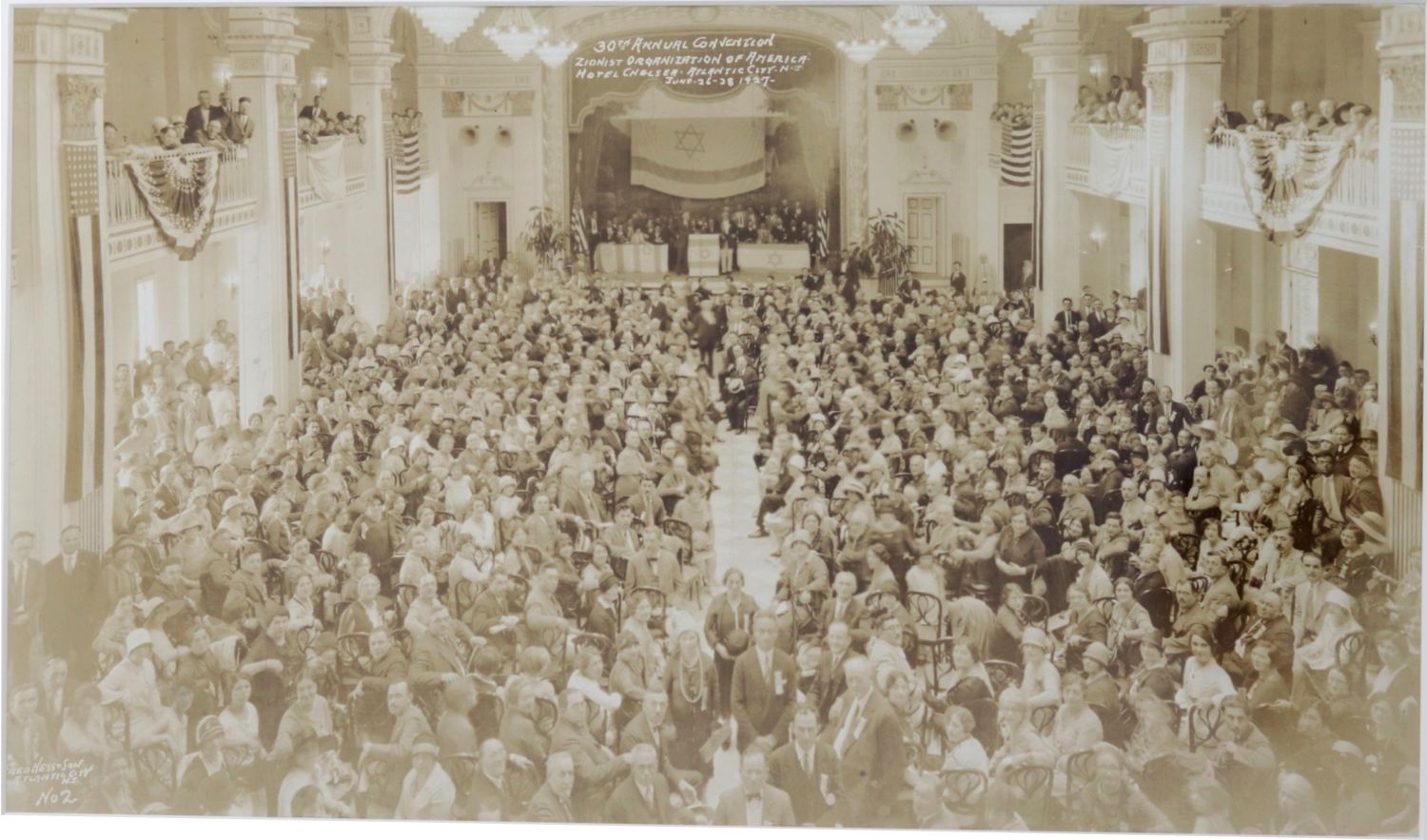
30th annual convention Zionist organization of america hotel chelser atlantic city - NJ, June 26-28 1927 - Huge photograph of hundreds of participants of the 30th convention of the Zionist Organization of America (ZOA) - held June 26-28, 1927 In New Jersey.
A photograph clearly showing the hundreds of participants in the conference hall. In the depth of the photograph around the stage, Israeli flags can be seen wrapped around the tables of honor, and above the podium.
The Zionist Organization of America (ZOA), established in 1897, is the first Jewish Zionist organization established in the United States. Was one of the main voices of Zionism in this country in the years before the establishment of the State of Israel and a key factor in enlisting the support of the American administration in the establishment of the State of Israel, especially when many Jewish groups did not support Zionism. Among the most famous leaders of the organization: Louis Brandeis, Stephen Samuel Wise, Abba Hillel Silver, Richard Gotheil (apparently the one who standing between the two Israeli flags in the photo), and more.
Size: 49x28 cm. Wooden frame: 62x41 cm. Very good condition.
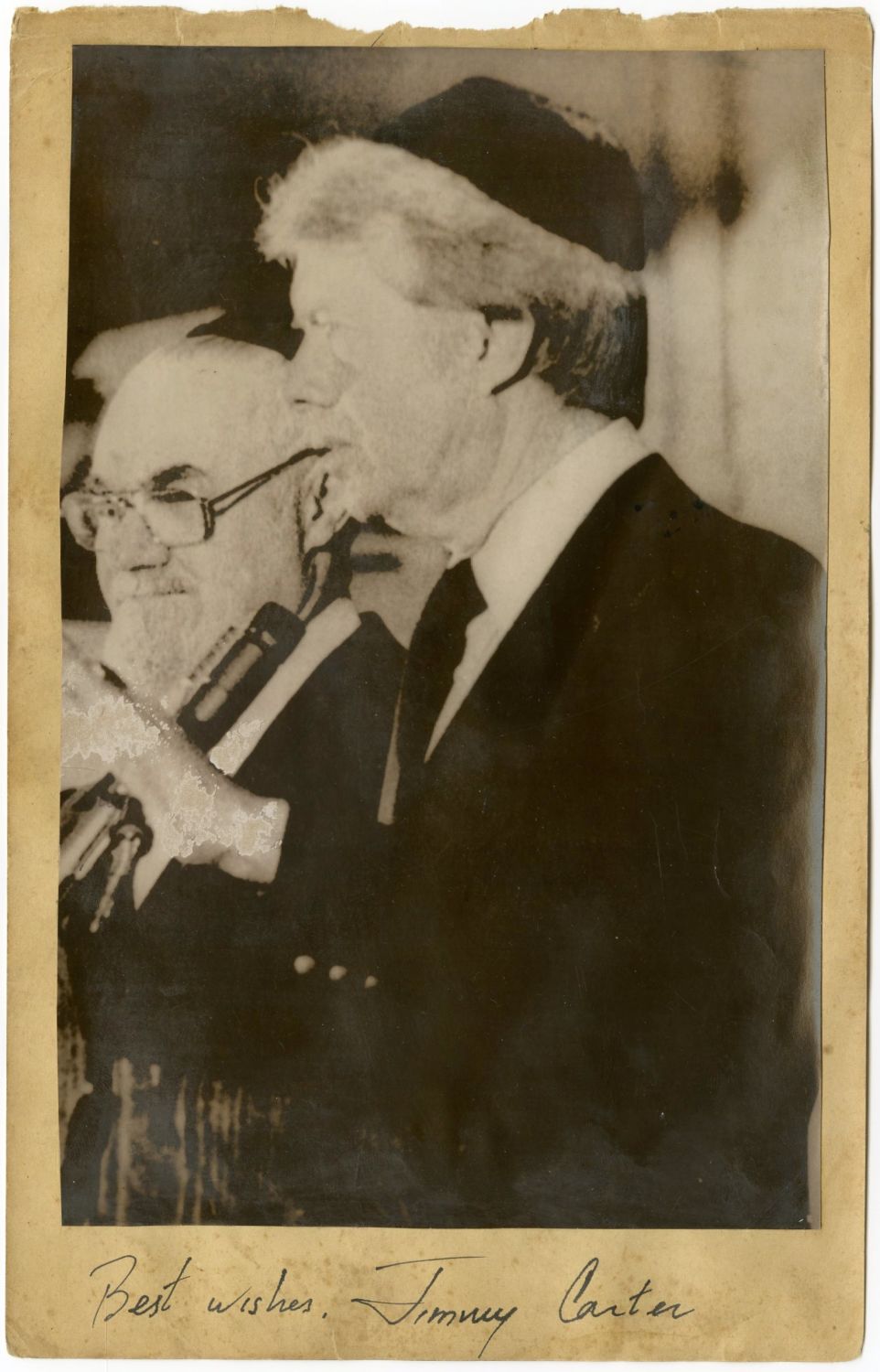
US President Jimmy Carter wearing a Kippah, alongside Rabbi Mordechai Phinehas Teitz of Elizabeth, speaking at the "Jewish Education Center" conference in Elizabeth, New Jersey, June 8, 1973 [Carter then headed the Democratic party, and came to Elizabeth to seek Jewish votes To his party]. Bellow the photo (affixed to cardboard, and rare in itself) is a handwritten dedication and Carter's signature: "Best wishes Jimmy Carter."
James Earl "Jimmy" Carter Jr. [born 1924] The 39th President of the United States from 1977-1981. Prior to his presidency, he served as governor of the 76th state of Georgia, from 1971 to 1975, after two terms in the Georgia Senate from 1963 to 1967.
Rabbi Mordechai Phinehas Teitz [1908-1996] Rabbi of Elizabeth, New Jersey. Member of the presidency of the Rabbinical Association of the United States and Canada, treasurer of "Ezrat Torah" and one of the leaders of the Rescue Committee. A student of the Salvodka Yeshiva in his youth. At the end of 1933, he traveled with Rabbi Eliyahu Meir Bloch on a one-year fundraising trip from North American Jewry for the Telz Yeshiva. While in the United States, Rabbi Bloch married him to Batya, the daughter of the late Rabbi of Elizabeth, New Jersey, Rabbi Elazar Meir Freil (a friend of Rabbi Bloch's father, Rabbi Yosef Leib, Rosh Yeshivat Telz) who died a month before coming to the United States. The wedding took place in January 1935, and he was appointed by his father-in-law's will as rabbi for his vacant seat. He joined the Rabbinical Association, and despite his young age was appointed chairman of the executive committee, but Provoked the indignation of some of the older generation in expressing his views on the duties of American rabbis, especially his demand that they deliver their sermons in English so as not to lose young people who did not knew Yiddish. He established in Elizabeth an Orthodox education system that included an elementary school (1941), a boys 'high school (1955), and a girls' high school called "Bruria" (1963). In 1981, after his repeated calls for members of the Rabbinical Association to open the ranks of the organization to young rabbis born in America, were denied, Rabbi Teitz, in collaboration with Rabbi Yaakov Kamintsky, a friend from his time studying in Slobodka, established a new rabbinical association called the Rabbinical Center. They received written backing from the greatest Lithuanians of the generation, Rabbi Yaakov Israel Kanevsky and Rabbi Elazar Menachem Shach. The main activity of the center was to refer kollel students after several years of schooling, to disseminate Torah in the periphery. In his old age, he appointed his son Rabbi Elazar Meir Teitz, who had been his deputy since 1958, to fill his place as rabbi of the city and to head the Jewish educational institutions in Elizabeth. He died on the 4th of Tevet, December 26, 1995, and was buried in the Mount of Olives cemetery in Jerusalem.
Size: 25x14 cm. Wooden and glass frame: 23x32 cm. Time stains on the brown margins, Tear at the top of the brown border without damaging the photo. good condition.
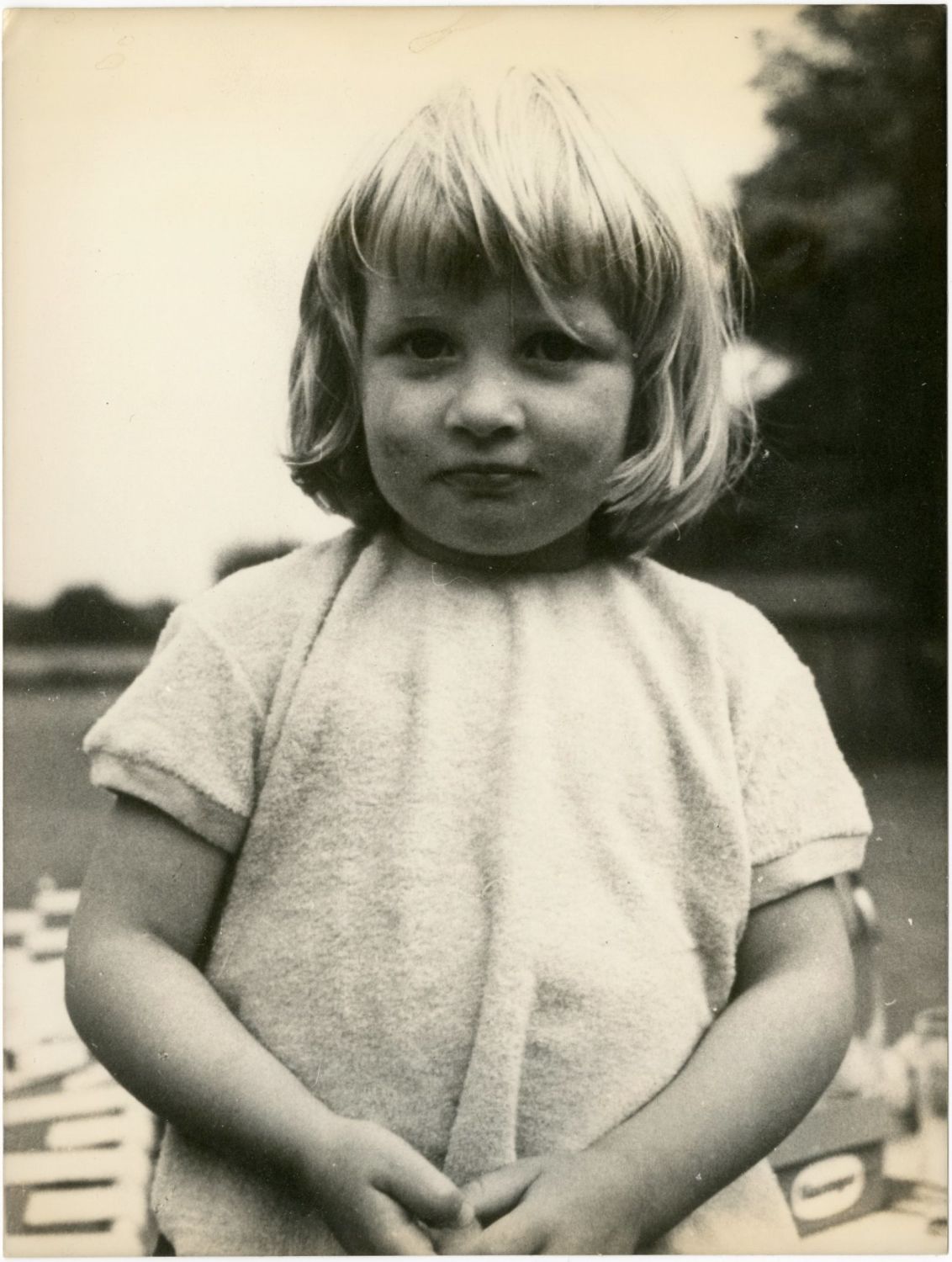
Five rare photographs of Princess Diana in her childhood. From a series of photos from the princess's private album released to the press on the occasion of her 20th birthday, in 1981.
The photographs are all depicted and dated on the back of the photographs on a printed piece of paper pasted on each of them.
Diana, Princess of Wales ; [Lady Diana Frances Spencer 1961-1997] A daughter of the Spencer House, was Charles's first wife, the Prince of Wales from 1981 until their divorce in 1996, and the mother of the second and sixth heir to the British Crown, the Prince William and Harry. From her marriage to a Prince of Wales in 1981 until her death in a car accident in Paris in 1997, Diana was one of the most recognized, photographed and beloved public figures in the United Kingdom and in the whole world. The world media has often called her the nickname "Lady Dee" or "Princess Dee". On August 31, 1997, Diana was killed in a car accident in a tunnel on the Pont de l'Alma in Paris, while trying to escape the vehicle in which she was being photographed by Parapchi.
Same size: 20x15 cm. Very good condition.
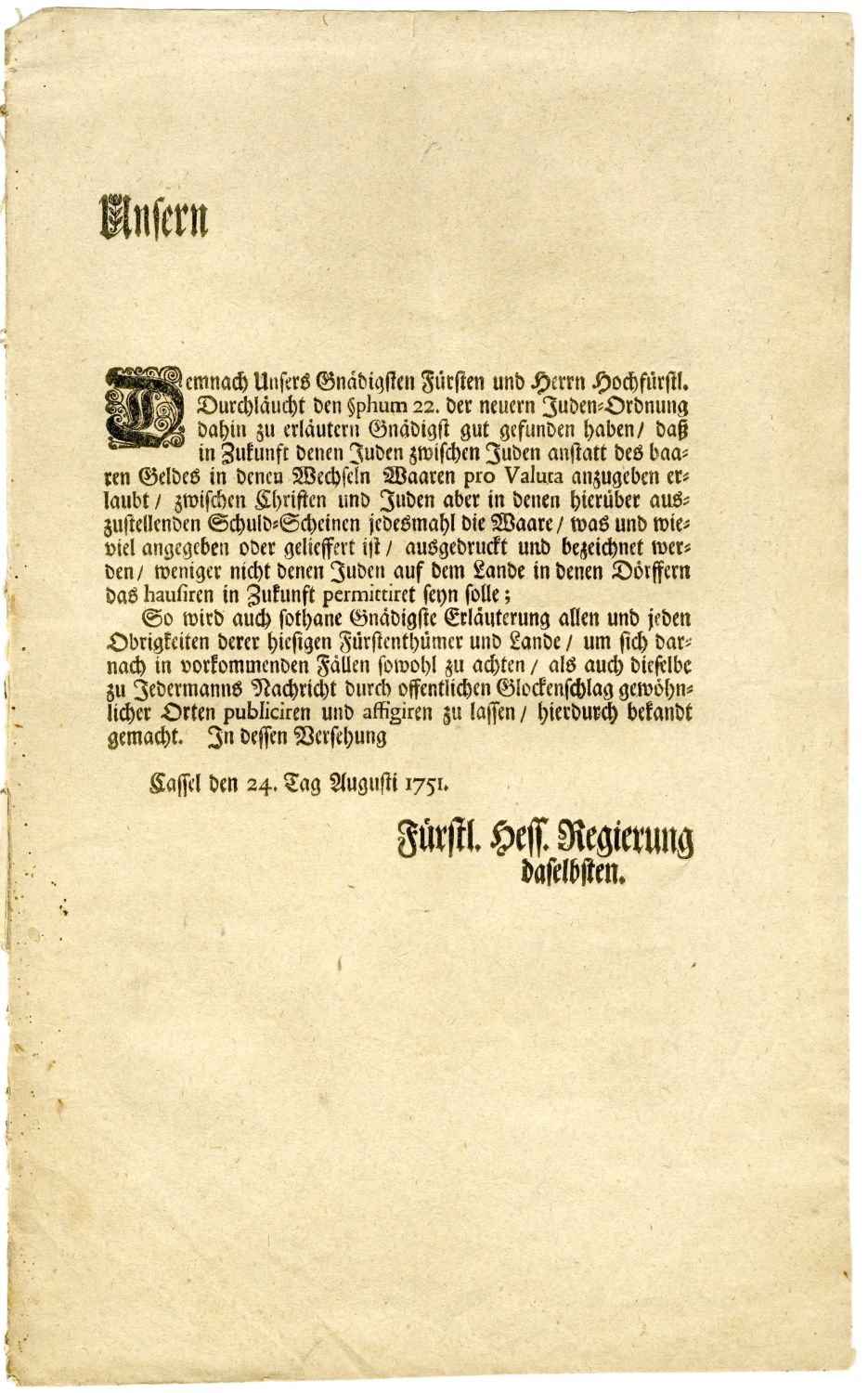
An antisemitic order detailing the terms of trade of Jews compared to Christians, and setting out preference clauses for Christians. Germany, August 1751.
The order states that the Jews of the villages will be a second priority compared to the residents of the cities when it comes to precedence in trade, and that Jews will not be allowed to buy in a round, and additional regulations regarding purchases that discriminate against Jews. At the end of the proclamation, it is written that the heads of the authorities must send representatives who will pass through the towns with a bell ringing to announce the new instructions to the Jewish public.
[1] leaf, 34x22 cm. Very good condition.
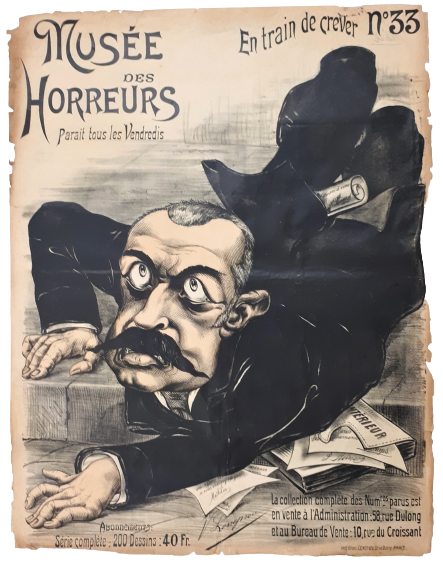
En train de crever - dying. Poster No. 33 from the Musée des Horreurs series ["Monsters Exhibition" / "Museum of Horrors"]. Paris, [1899-1900]. A hand-painted lithographic print featuring former French President Pierre Waldeck-Rousseau slips and falls on the sidewalk, with various documents related to the prosecution testimony against Dreyfus falling out of his pocket. The illustrator intended to present the fact that the evidence incriminating Dreyfus collapses one after another. Published in May 1900. Signed by V. Lenepveu. French.
The series "Monsters Exhibition" was published during the Dreyfus affair under a pseudonym, and included 51 large posters with anti-Dreyfus illustrations, antisemitic, and against the "Bonim". The series was published in France over a period of about a year, between October 1899 and December 1900. The original plan was to issue 200 Posters in the series, but in fact only 51 came out. The first posters in the series sold over 300,000 copies. In October 1899 the French police arrested a number of peddlers who sold posters from the series on the orders of District Commander Louis Lapin. According to some reports, Lapin ordered the distribution of posters to be stopped following a request he received from Baron de Rothschild, who claimed that the damage in distributing them was irreversible. In February 1900 the local police sent letters in which they threatened to revoke the trade license from Merchants who would sell the posters, and since then their distribution has stopped.
65X50 cm. Slight tears in margins - Reinforced with paper gluing on the back. Good condition.
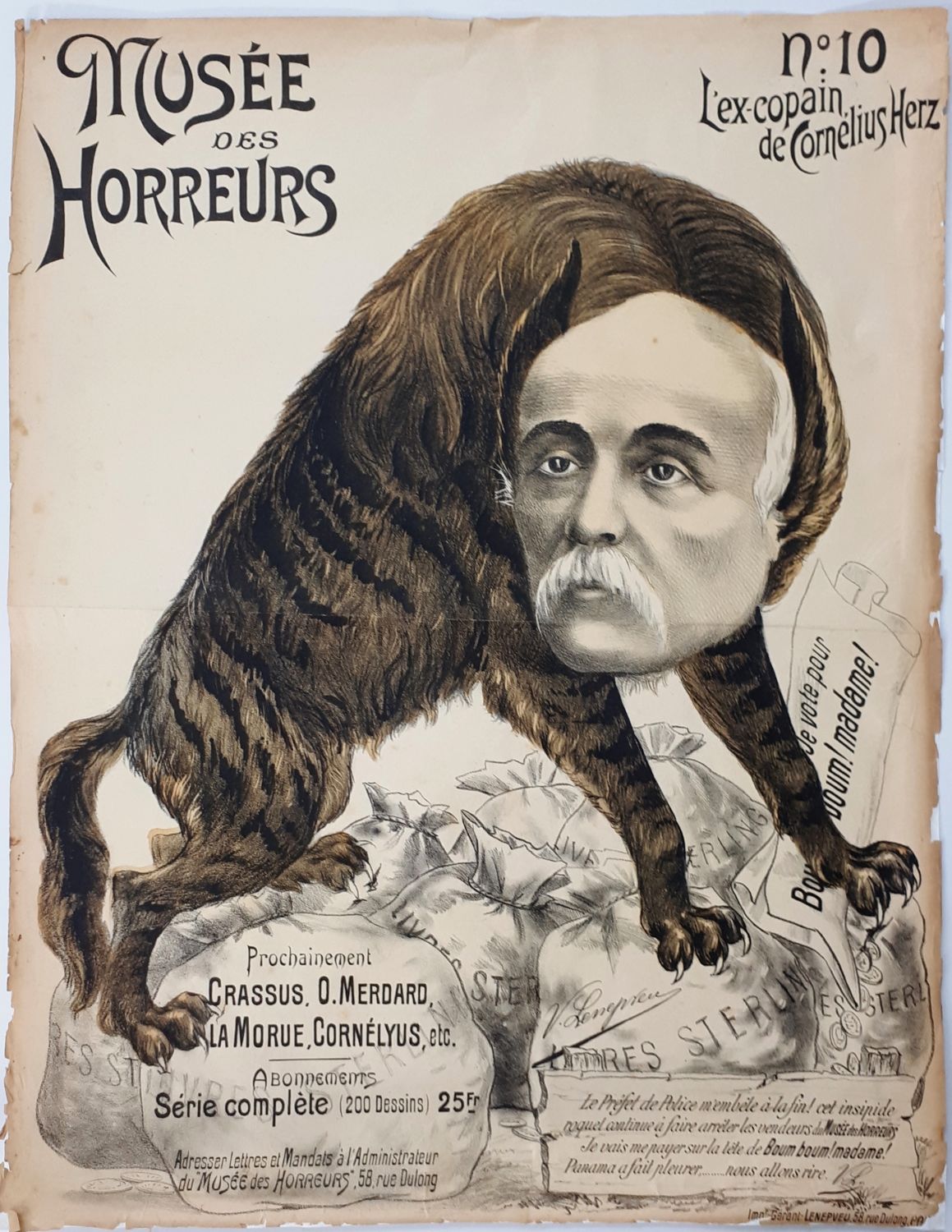
L'ex-copain de Cornélius Herz - - Ex-friend of Cornelius Hertz. Poster No. 10 from the Musée des Horreurs series ["Monsters Exhibition" / "Museum of Horrors"]. Paris, [1899-1900]. Hand-painted lithographic print depicting Georges Clemenceau as Hyaenidae, holding bags of pounds sterling, Alludes to the accusations made in the Norton case (1893). The title of the Poster is reminiscent of his connections with Cornelius Hertz before the Panama Scandal (1892). Clemenceau, a French statesman who has twice served as prime minister of France and is considered one of Dreyfus' supporters, published in 1898 in the newspaper "L'Aurore" Emil Zola's article "J'accuse" - "I blame", Proving Dreyfus' innocence, and even dedicated the title page to it. Teh poster Published in December 1899, signed by V. Lenepveu. French.
The series "Monsters Exhibition" was published during the Dreyfus affair under a pseudonym, and included 51 large posters with anti-Dreyfus illustrations, antisemitic, and against the "Bonim". The series was published in France over a period of about a year, between October 1899 and December 1900. The original plan was to issue 200 Posters in the series, but in fact only 51 came out. The first posters in the series sold over 300,000 copies. In October 1899 the French police arrested a number of peddlers who sold posters from the series on the orders of District Commander Louis Lapin. According to some reports, Lapin ordered the distribution of posters to be stopped following a request he received from Baron de Rothschild, who claimed that the damage in distributing them was irreversible. In February 1900 the local police sent letters in which they threatened to revoke the trade license from Merchants who would sell the posters, and since then their distribution has stopped.
65X50 cm. Slight tears in margins - Reinforced with paper gluing on the back. Good condition.
Created and Develop with 🤍By webe ©2024